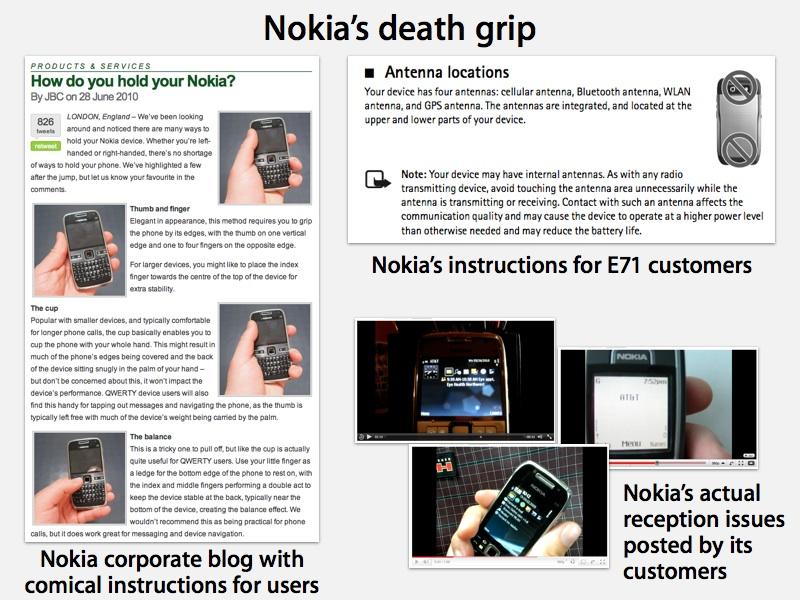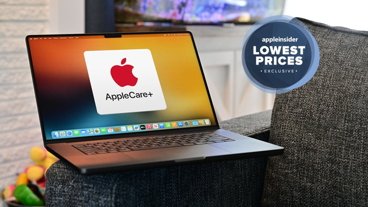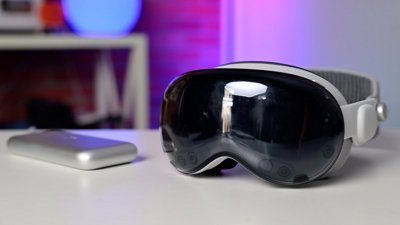Nokia kicks off Windows Phone 7 campaign with Antennagate teaser spot
An unbranded "Smartphone Beta Test" website, counting down to the launch of Nokia's AT&T debut, fictitiously documents a series of supposed design flaws alluding to the fragility of the iPhone's touch screen and the "death grip" associated with iPhone 4 and its Antennagate issue launched by Gizmodo nearly two years ago.
Other spots, each modeled to look like security camera footage of internal design meetings, highlight flaws with Android phones using OLED screens that only work well inside, creating an overall impression that the smartphone category has been in beta for years, waiting for Microsoft and Nokia to finally release a "non-beta" phone.
Nokia has already launched its Lumia 710 in the US via T-Mobile, but after rapidly falling out of even that carrier's top three phones at the hands of Android competitors, the once leading vendor of smartphones is now hoping to relaunch Lumia in the US with AT&T, a much larger partner.
Without being able to draw attention to the popularity of Windows Phone 7 or a diverse, rich selection of apps for the platform, Nokia appears to be aiming at drawing attention to the real or imagined flaws of its competitors.
Death Grip
Ironically, Nokia's "Death Grip" spot appears to be trying to associate poor antenna performance from "holding it wrong" with iPhone 4, as a tester in the video complains, "shouldn't I be able to hold it however I want?"
Back in 2010, Nokia attempted to make hay from Antennagate by blogging, "providing a wide range of methods and grips for people to hold their phones, without interfering with the antennae, has been an essential feature of every device Nokia has built," and insisting, "you’re free to hold your Nokia device any way you like. And you won’t suffer any signal loss. Cool, huh?"
At the same time, Nokia had long instructed its users to "avoid touching the antenna area unnecessarily while the antenna is transmitting or receiving," and noted in its product manuals that "contact with antennas affects the communication quality and may cause the device to operate at a higher power level than otherwise needed and my reduce the battery life."
Following Nokia's potshots at the iPhone 4's antenna, the company's users posted a variety of videos to YouTube highlighting the same hand-blocking of signal on Nokia's E71, 6230 and 6720 models.
Nokia's similar addressing of OLED screens as a "beta" design mistake are also brow raising, given that the company was among the first to promote OLED screens for use on smartphones, starting with a rebranded Pantech feature phone it attempted to sell in the US back in 2006 as the 6215i; the high end N85 and N86 models it released beginning in 2008 to compete against Apple's iPhone and the newer N8 that was supposed to make Nokia's Symbian a credible contender to iPhone 4.
AT&T has stated its Lumia launch with Nokia will be a "notch above anything we've ever done," powered by another $100 million of advertising pooled by Microsoft among WP7 partners, of whom AT&T has been signed up to give the new Lumia model "hero" status as a heavily promoted device in its retail stores.
Microsoft reportedly allocated $500 million to push WP7 at its launch in late 2010. Its executives also indicated that the company, carriers and manufacturing partners would collectively spend "billions" of dollars marketing WP7 devices during its first year. Those efforts failed to materialize in the form of significant WP7 phone sales however.
According to end of year figures by the NPD Group, Windows Phone's smartphone market share has not topped 2 percent since it launched. Meanwhile, sales of Android and iOS handsets reached a combined 82 percent of the market in the first three quarters of 2011 the firm stated. Nielsen estimated Windows Phone's share of the market for the third quarter of 2011 alone as just 1.2 percent.
Nokia has tied its smartphone strategy to Microsoft's WP7 platform after ditching its own failed experiment with open sourcing the Symbian platform it cultivated over the past decade, and a brief patterning with Intel to create MeeGo as a separate, open platform for smartphones and mobile devices.
 Daniel Eran Dilger
Daniel Eran Dilger













 Bon Adamson
Bon Adamson
 Andrew Orr
Andrew Orr
 Amber Neely
Amber Neely
 William Gallagher and Mike Wuerthele
William Gallagher and Mike Wuerthele
 Malcolm Owen
Malcolm Owen

 Wesley Hilliard
Wesley Hilliard
 Christine McKee
Christine McKee









134 Comments
People who live in glass houses...
Lame , lame lame.
I still have the first iPhone 4 and I have never, ever had a dropped call from the so called death grip. And why now. Why bring up this old issue nearly two damn years later?
Pathetic. Pathetic nokia.
1) There are two more of these teaser ads on Nokia's website. I'd say that two are attacking the iPhone, not just the deathgrip ad.
2) I'm not sure if they are effective as I hear they are confusing if you don't already know the inside story before watching them, but they are funny.
3) Does the use of SNL's Chris Parnell on their website point to a significant US focus?
Lame , lame lame.
I still have the first iPhone 4 and I have never, ever had a dropped call from the so called death grip. And why now. Why bring up this old issue nearly two damn years later?
Pathetic. Pathetic nokia.
1) Campaigns aren't about the truth, it's about using fear and ignorance to sway you. Emotion is a powerful thing and has nothing to with rational thought.
2) I'm still on my iPhone 4 (returned iPhone 4S because of battery issues). I also haven't been using a Bumper for about a year as I went through several rather quickly.
Resurrecting a 2-year old iPhone controversy that few people remember as part of the ad campaign for your new phone? Did Nokia actually PAY someone to come up with this? This is the dumbest marketing idea I've heard in a long long time.
That horse was beaten to death, buried, eulogized, and forgotten two years ago.
So not only is Nokia and Microsoft late to the party, so is their marketing.